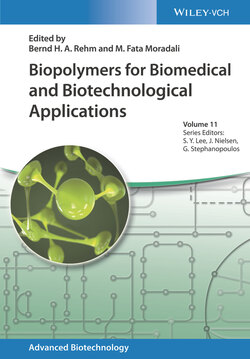Читать книгу Biopolymers for Biomedical and Biotechnological Applications - Группа авторов - Страница 20
References
Оглавление1 1 Rebelo, R., Fernandes, M., and Fangueiro, R. (2017). Biopolymers in medical implants: a brief review. Procedia Engineering 200: 236–243.
2 2 Yadav, P., Yadav, H., Shah, V.G. et al. (2015). Biomedical biopolymers, their origin and evolution in biomedical sciences: a systematic review. Journal of Clinical and Diagnostic Research: JCDR 9 (9): ZE21.
3 3 Sahana, T. and Rekha, P. (2018). Biopolymers: applications in wound healing and skin tissue engineering. Molecular Biology Reports 45: 2857–2867.
4 4 Labet, M. and Thielemans, W. (2009). Synthesis of polycaprolactone: a review. Chemical Society Reviews 38 (12): 3484–3504. https://doi.org/10.1039/B820162P.
5 5 Chien, L.J. and Lee, C.K. (2007). Enhanced hyaluronic acid production in Bacillus subtilis by coexpressing bacterial hemoglobin. Biotechnology Progress 23 (5): 1017–1022.
6 6 Chien, L.J. and Lee, C.K. (2007). Hyaluronic acid production by recombinant Lactococcus lactis. Applied Microbiology and Biotechnology 77 (2): 339–346.
7 7 Liu, L., Wang, M., Du, G., and Chen, J. (2008). Enhanced hyaluronic acid production of Streptococcus zooepidemicus by an intermittent alkaline‐stress strategy. Letters in Applied Microbiology 46 (3): 383–388.
8 8 Helenius, G., Bäckdahl, H., Bodin, A. et al. (2006). In vivo biocompatibility of bacterial cellulose. Journal of Biomedical Materials Research Part A 76A (2): 431–438.
9 9 Hoenich, N.A. (2007). Cellulose for medical applications: past, present, and future. BioResources 1 (2): 270–280.
10 10 Rockwood, D.N., Preda, R.C., Yücel, T. et al. (2011). Materials fabrication from Bombyx mori silk fibroin. Nature Protocols 6 (10): 1612–1631.
11 11 Auras, R.A., Lim, L.‐T., Selke, S.E., and Tsuji, H. (2011). Poly(lactic Acid): Synthesis, Structures, Properties, Processing, and Applications. Wiley.
12 12 ISO/TS 21726:2019 (2016). Biological evaluation of medical devices – Application of the threshold of toxicological concern (TTC) for assessing biocompatibility of medical device constituents. Standardization IOf.
13 13 Kroes, R., Kleiner, J., and Renwick, A. (2005). The threshold of toxicological concern concept in risk assessment. Toxicological Sciences 86 (2): 226–230.
14 14 Munro, I., Renwick, A., and Danielewska‐Nikiel, B. (2008). The threshold of toxicological concern (TTC) in risk assessment. Toxicology Letters 180 (2): 151–156.
15 15 Hennes, E. (2012). An overview of values for the threshold of toxicological concern. Toxicology Letters 211 (3): 296–303.
16 16 Guideline IHT (2014). Assessment and control of DNA reactive (mutagenic) impurities in pharmaceuticals to limit potential carcinogenic risk. International Conference on Harmonization of Technical Requirements for Registration of Pharmaceuticals for Human Use (ICH), Geneva. Citeseer (31 May 2017). http://academy.gmp-compliance.org/guidemgr/files/M7_R1_ADDENDUM_STEP_4_2017_0331.PDF
17 17 European Food Safety Authority and World Health Organization (2016). Review of the Threshold of Toxicological Concern (TTC) Approach and Development of New TTC Decision Tree. EFSA Supporting publication 2016:EN‐1006. https://efsa.onlinelibrary.wiley.com/doi/pdf/10.2903/sp.efsa.2016.EN-1006
18 18 Cramer, G., Ford, R., and Hall, R. (1976). Estimation of toxic hazard – a decision tree approach. Food and Cosmetics Toxicology 16 (3): 255–276.
19 19 Munro, I.C., Ford, R.A., Kennepohl, E., and Sprenger, J. (1996). Correlation of structural class with no‐observed‐effect levels: a proposal for establishing a threshold of concern. Food and Chemical Toxicology 34 (9): 829–867.
20 20 Weng, W., Song, S., Cao, L. et al. (2014). A comparative study of bioartificial bone tissue poly‐l‐lactic acid/polycaprolactone and PLLA scaffolds applied in bone regeneration. Journal of Nanomaterials 2014: 236.
